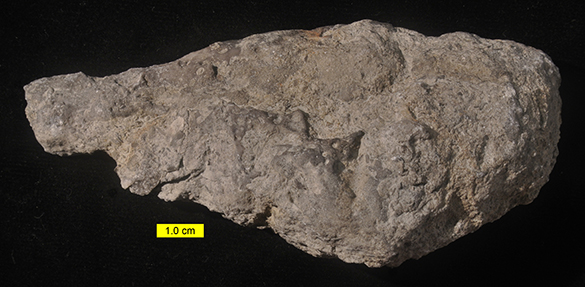 It doesn’t look like much, this long lump of gray stone. With a close view you might pick up a hint of a bryozoan or two, but mostly we see rather shabby shades of grey. One of the coolest perks of being a geologist, though, is that you get to use a saw to cut rocks in half to see what’s inside. So that’s what I did with this specimen from the Whitewater Formation (Upper Ordovician) of southeastern Indiana at a site we’ve visited often.
It doesn’t look like much, this long lump of gray stone. With a close view you might pick up a hint of a bryozoan or two, but mostly we see rather shabby shades of grey. One of the coolest perks of being a geologist, though, is that you get to use a saw to cut rocks in half to see what’s inside. So that’s what I did with this specimen from the Whitewater Formation (Upper Ordovician) of southeastern Indiana at a site we’ve visited often.
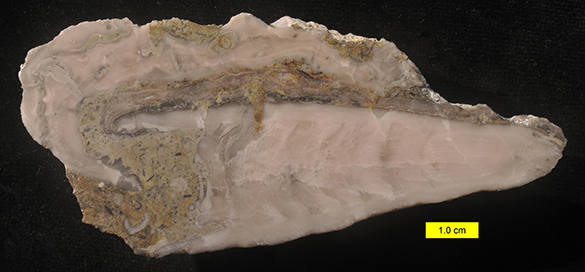 In this cross-section we see first a long, cone-shaped fossil made of white calcite. It is the rugose coral Grewingkia canadensis, one of the most common fossils in the upper part of the Upper Ordovician. This coral in life would have stood upright like an ice cream cone, spreading the tentacles of its polyp to catch very small swimming prey (and maybe to do a bit of symbiotic photosynthesis). The polyp sat in the cup-like cavity on the expanded end of the cone. The coral evidently died on the Ordovician seafloor and toppled over to be encrusted on one side, presumably the one that faced upwards.
In this cross-section we see first a long, cone-shaped fossil made of white calcite. It is the rugose coral Grewingkia canadensis, one of the most common fossils in the upper part of the Upper Ordovician. This coral in life would have stood upright like an ice cream cone, spreading the tentacles of its polyp to catch very small swimming prey (and maybe to do a bit of symbiotic photosynthesis). The polyp sat in the cup-like cavity on the expanded end of the cone. The coral evidently died on the Ordovician seafloor and toppled over to be encrusted on one side, presumably the one that faced upwards.
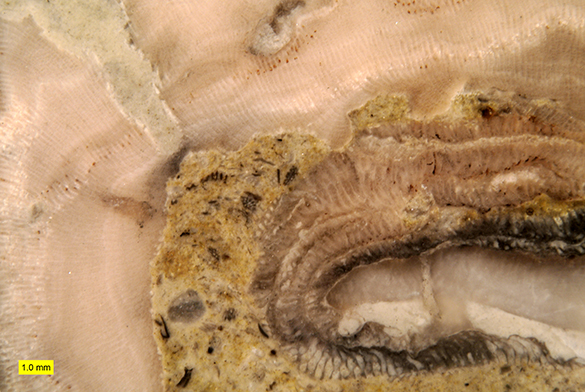 This is a closer view of the cross-section showing the encrustations on the rugose coral skeleton. The image is annotated below.
This is a closer view of the cross-section showing the encrustations on the rugose coral skeleton. The image is annotated below.
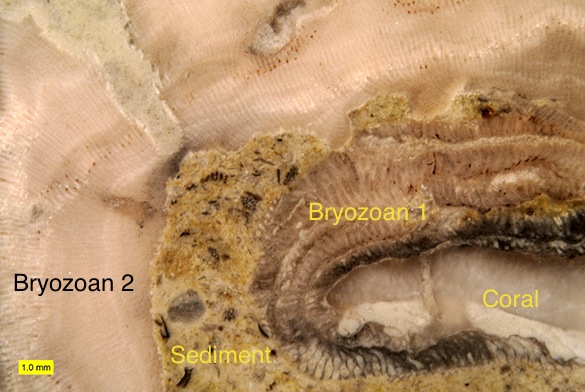 The coral skeleton in the lower right was first encrusted by a trepostome bryozoan, which you can recognize by the tubes (zooecia) extending perpendicular from the substrate. This bryozoan is thickest on the upwards-facing surface of the coral, and it thins as it wraps around and then colonizes the cryptic space beneath (but not too far). This bryozoan is covered with a layer of sediment which appears to have rapidly cemented in place (a function of Calcite Sea geochemistry). The sediment then is encrusted by a another trepostome bryozoan with long zooecia and several layers.
The coral skeleton in the lower right was first encrusted by a trepostome bryozoan, which you can recognize by the tubes (zooecia) extending perpendicular from the substrate. This bryozoan is thickest on the upwards-facing surface of the coral, and it thins as it wraps around and then colonizes the cryptic space beneath (but not too far). This bryozoan is covered with a layer of sediment which appears to have rapidly cemented in place (a function of Calcite Sea geochemistry). The sediment then is encrusted by a another trepostome bryozoan with long zooecia and several layers.
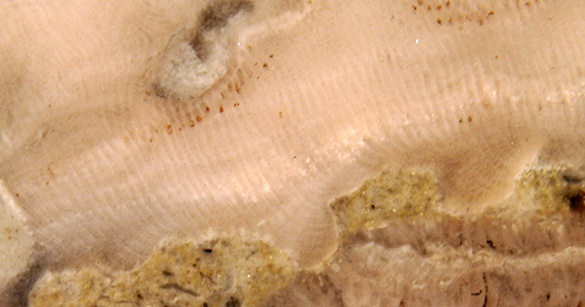 In this closer view of the second bryozoan you can see that its base is irregular as it grew across the rough cemented sediment surface. In the middle of this view some of the bryozoan zooecia are occupied by dark spots known as brown bodies. These are likely the remains of bryozoan polypides (main parts of the individual zooids) that were sealed into their zooecia by some disturbance. In this case the whitish bit of sediment above the cluster may represent something that settled on the colony, stopping the growth of the zooecia below, and forcing those nearby to grow around it.
In this closer view of the second bryozoan you can see that its base is irregular as it grew across the rough cemented sediment surface. In the middle of this view some of the bryozoan zooecia are occupied by dark spots known as brown bodies. These are likely the remains of bryozoan polypides (main parts of the individual zooids) that were sealed into their zooecia by some disturbance. In this case the whitish bit of sediment above the cluster may represent something that settled on the colony, stopping the growth of the zooecia below, and forcing those nearby to grow around it.
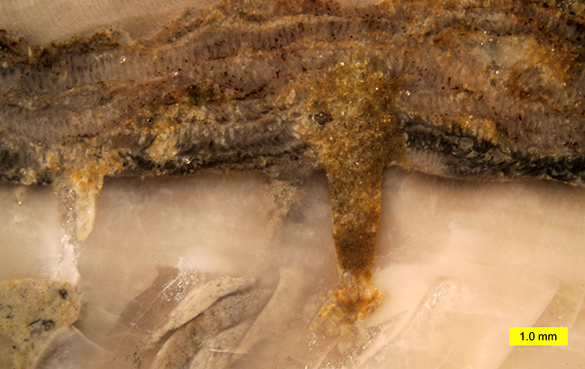 Moving down the coral skeleton away from its opening we come across borings drilled down through the coral skeleton (the white mass at the bottom of the image). The conical, large boring is filled with golden crystals of the mineral dolomite, which were formed long after burial. The shape of this boring is unusual. Typical borings in these corals have straight parallel sides, but this boring is cone-shaped. We’ll see if we can find more like it to get a better idea of its shape and distribution.
Moving down the coral skeleton away from its opening we come across borings drilled down through the coral skeleton (the white mass at the bottom of the image). The conical, large boring is filled with golden crystals of the mineral dolomite, which were formed long after burial. The shape of this boring is unusual. Typical borings in these corals have straight parallel sides, but this boring is cone-shaped. We’ll see if we can find more like it to get a better idea of its shape and distribution.
This week’s fossil, then, is a demonstration of the hidden wonders sometimes found in even the dullest of grey rocks!


